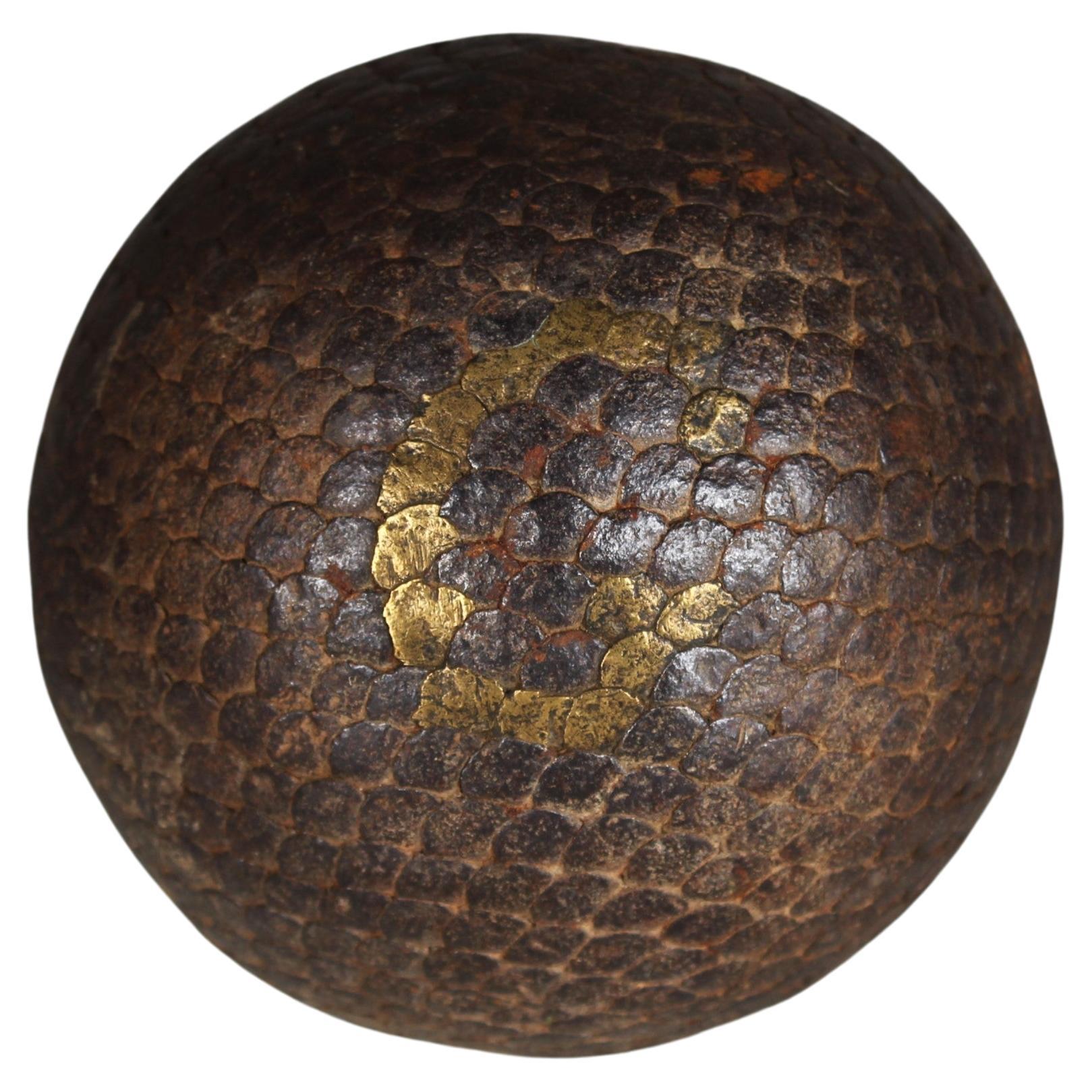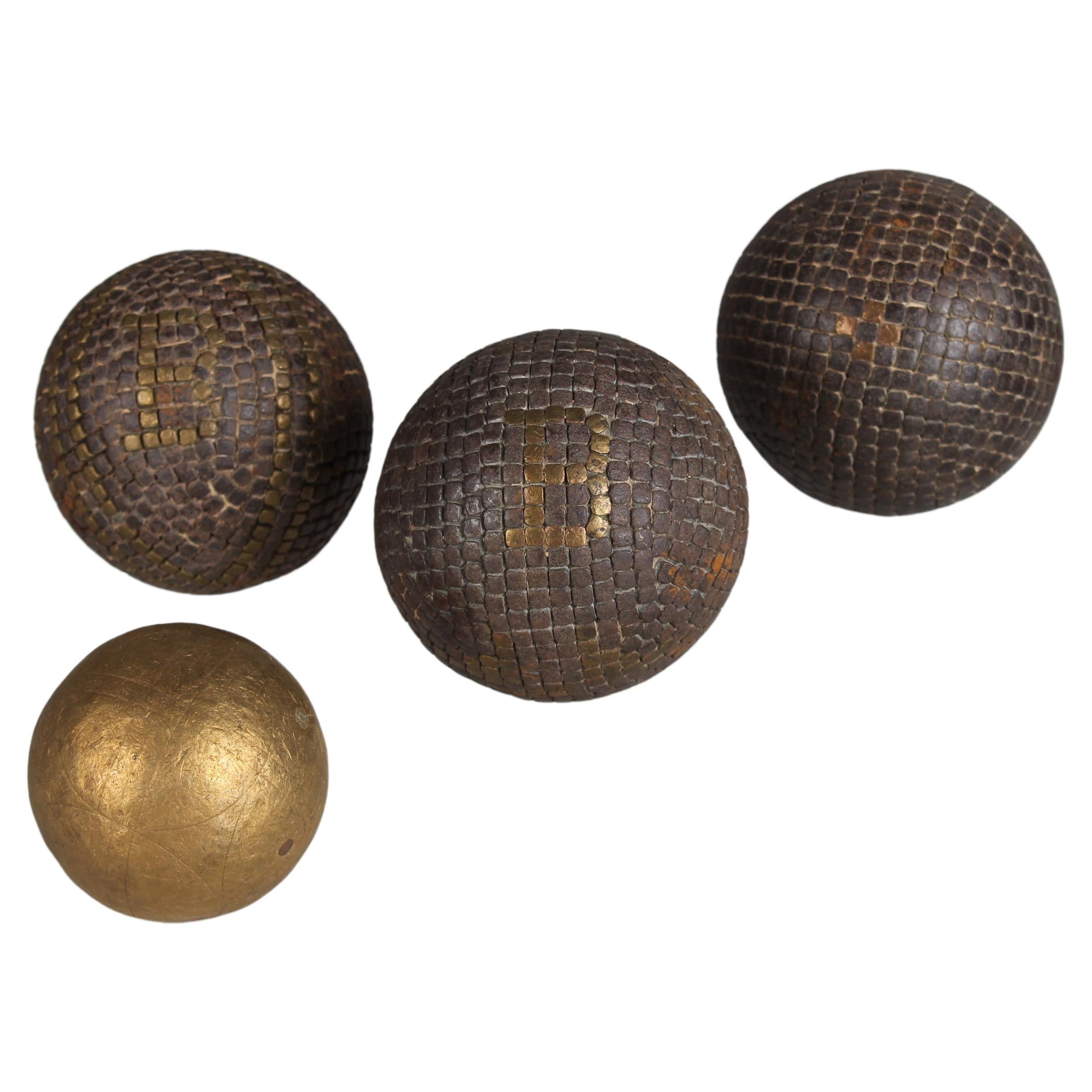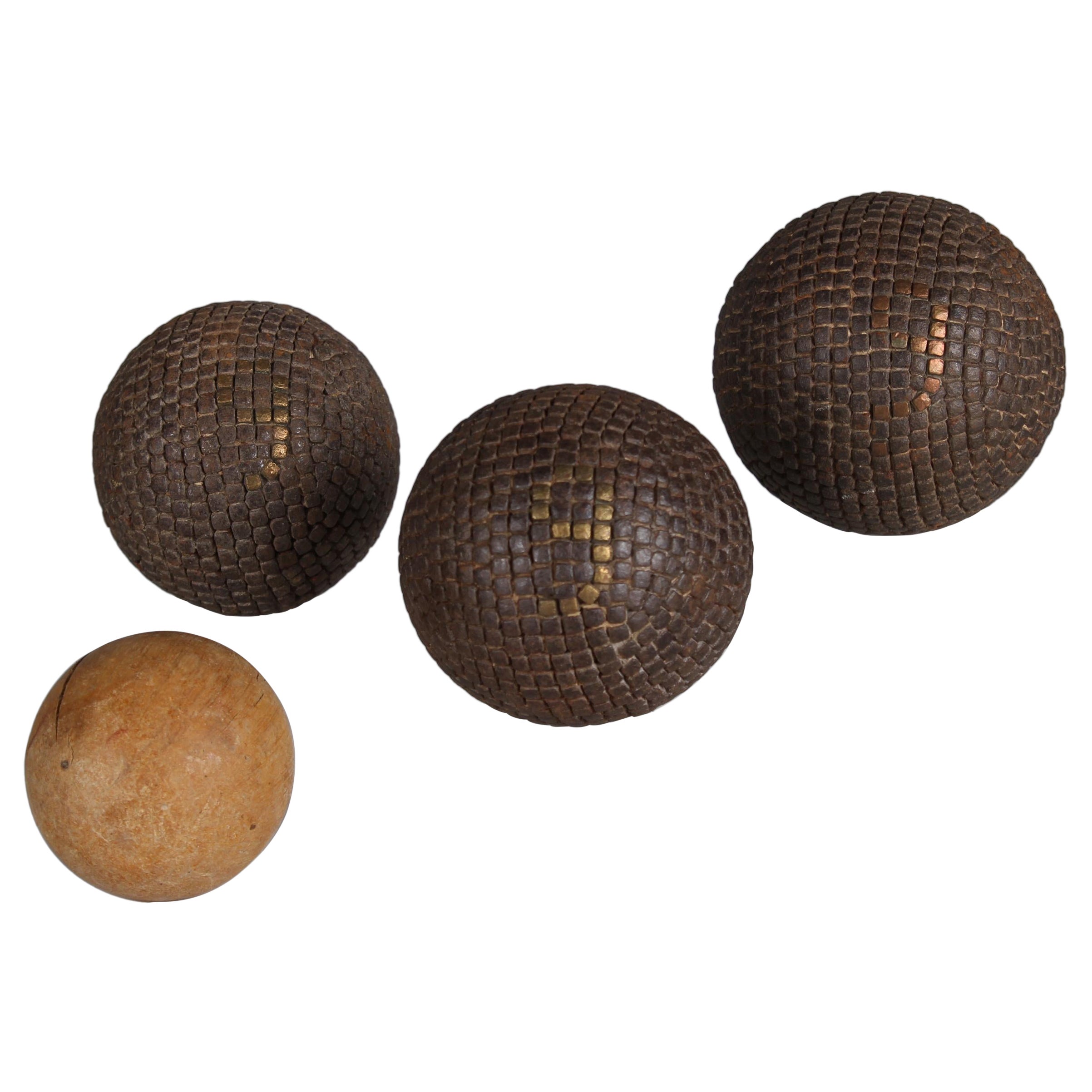Items Similar to Antique Bassinoire, Warming Pan, Copper, France, 1880s
Want more images or videos?
Request additional images or videos from the seller
1 of 12
Antique Bassinoire, Warming Pan, Copper, France, 1880s
About the Item
Beautiful copper pan from France, a so-called Bassinoire.
The lid can be opened with an external lever.
This antique form of a todays hot-water bottle was primarily used in aristocratic homes in the 18th and 19th centuries.
Hot coals were poured into the container and then placed in bed to warm up.
This warmer has a beautiful decorative lid.
- Dimensions:Height: 3.55 in (9 cm)Diameter: 9.45 in (24 cm)
- Materials and Techniques:
- Place of Origin:
- Period:
- Date of Manufacture:Circa 1880
- Condition:Nice and cleaned condition with signs of age and use.
- Seller Location:Greven, DE
- Reference Number:1stDibs: LU5419237668432
About the Seller
5.0
Platinum Seller
These expertly vetted sellers are 1stDibs' most experienced sellers and are rated highest by our customers.
Established in 2014
1stDibs seller since 2020
118 sales on 1stDibs
Typical response time: <1 hour
- ShippingRetrieving quote...Ships From: Münster, Germany
- Return PolicyA return for this item may be initiated within 14 days of delivery.
More From This SellerView All
- Antique Boule Ball "7", Pétanque, 1880s, France, CraftsmanshipLocated in Greven, DEBeautiful, unique Boule ball, France, late 19th Century. In the 19th century, the manufacture of boules balls underwent significant development in France as the game of boules, particularly the pétanque variant, gained in popularity. The manufacture of boules balls during this period was a manual process that required expertise, precision and love to detail. In the late 19th and early 20th centuries, particularly in rural areas of France and other Mediterranean regions, olive wood was a commonly used source of material for making boules balls. This was not only due to the availability of the material, but also to the outstanding properties of olive wood, which was characterized by hardness, strength and a rich grain. First, the olive wood was carefully selected and shaped into raw balls, which were then sanded to the desired size and shape. The nails were then hammered into the balls one by one, making sure that they were evenly distributed and firmly anchored. Finally, the spheres were polished and coated with a protective varnish to enhance their natural beauty and protect them from the elements. The use of nails to decorate and reinforce olive wood boules was a traditional practice that not only gave the ball a rustic aesthetic, but also improved its durability and contributed to customization. Many balls were made according to the specific requirements and preferences of the players. Nails were driven at regular intervals around the ball, with each nail hole precisely placed so as not to affect the balance and weight distribution of the ball. These nails not only served as a decorative element, but also helped to strengthen the structure of the ball and make it more resistant to the hard knocks and wear and tear during play. Individual engravings or decorations were often applied to the balls to make them unique and identify the player. Antique boules...Category
Antique Late 19th Century French Late Victorian Antiquities
MaterialsMetal
- Antique Boule Ball "G", "J", Pétanque, 1880s, France, CraftsmanshipLocated in Greven, DEBeautiful, unique Boule ball, France, late 19th Century. Decorated with the initials "G" and "J". In the 19th century, the manufacture of boules balls underwent significant developm...Category
Antique Late 19th Century French Late Victorian Antiquities
MaterialsOlive
- Antique Boule Ball "G", Pétanque, 1880s, France, CraftsmanshipLocated in Greven, DEBeautiful, unique Boule ball, France, late 19th Century. In the 19th century, the manufacture of boules balls underwent significant development in France as the game of boules, particularly the pétanque variant, gained in popularity. The manufacture of boules balls during this period was a manual process that required expertise, precision and love to detail. In the late 19th and early 20th centuries, particularly in rural areas of France and other Mediterranean regions, olive wood was a commonly used source of material for making boules balls. This was not only due to the availability of the material, but also to the outstanding properties of olive wood, which was characterized by hardness, strength and a rich grain. First, the olive wood was carefully selected and shaped into raw balls, which were then sanded to the desired size and shape. The nails were then hammered into the balls one by one, making sure that they were evenly distributed and firmly anchored. Finally, the spheres were polished and coated with a protective varnish to enhance their natural beauty and protect them from the elements. The use of nails to decorate and reinforce olive wood boules was a traditional practice that not only gave the ball a rustic aesthetic, but also improved its durability and contributed to customization. Many balls were made according to the specific requirements and preferences of the players. Nails were driven at regular intervals around the ball, with each nail hole precisely placed so as not to affect the balance and weight distribution of the ball. These nails not only served as a decorative element, but also helped to strengthen the structure of the ball and make it more resistant to the hard knocks and wear and tear during play. Individual engravings or decorations were often applied to the balls to make them unique and identify the player. Antique boules...Category
Antique Late 19th Century French Late Victorian Antiquities
MaterialsMetal
- Antique Boule Ball "G", Pétanque, 1880s, France, CraftsmanshipLocated in Greven, DEBeautiful, unique Boule ball, France, late 19th Century. In the 19th century, the manufacture of boules balls underwent significant development in France as the game of boules, particularly the pétanque variant, gained in popularity. The manufacture of boules balls during this period was a manual process that required expertise, precision and love to detail. In the late 19th and early 20th centuries, particularly in rural areas of France and other Mediterranean regions, olive wood was a commonly used source of material for making boules balls. This was not only due to the availability of the material, but also to the outstanding properties of olive wood, which was characterized by hardness, strength and a rich grain. First, the olive wood was carefully selected and shaped into raw balls, which were then sanded to the desired size and shape. The nails were then hammered into the balls one by one, making sure that they were evenly distributed and firmly anchored. Finally, the spheres were polished and coated with a protective varnish to enhance their natural beauty and protect them from the elements. The use of nails to decorate and reinforce olive wood boules was a traditional practice that not only gave the ball a rustic aesthetic, but also improved its durability and contributed to customization. Many balls were made according to the specific requirements and preferences of the players. Nails were driven at regular intervals around the ball, with each nail hole precisely placed so as not to affect the balance and weight distribution of the ball. These nails not only served as a decorative element, but also helped to strengthen the structure of the ball and make it more resistant to the hard knocks and wear and tear during play. Individual engravings or decorations were often applied to the balls to make them unique and identify the player. Antique boules...Category
Antique Late 19th Century French Late Victorian Antiquities
MaterialsMetal
- Antique Boule Balls Set "9", Pétanque, 1880s, France, CraftsmanshipLocated in Greven, DEBeautiful, unique Boule set of three Boule balls and one target ball, France, late 19th century. In the 19th century, the manufacture of boules balls underwent significant development in France as the game of boules, particularly the pétanque variant, gained in popularity. The manufacture of boules balls during this period was a manual process that required expertise, precision and love to detail. In the late 19th and early 20th centuries, particularly in rural areas of France and other Mediterranean regions, olive wood was a commonly used source of material for making boules balls. This was not only due to the availability of the material, but also to the outstanding properties of olive wood, which was characterized by hardness, strength and a rich grain. First, the olive wood was carefully selected and shaped into raw balls, which were then sanded to the desired size and shape. The nails were then hammered into the balls one by one, making sure that they were evenly distributed and firmly anchored. Finally, the spheres were polished and coated with a protective varnish to enhance their natural beauty and protect them from the elements. The use of nails to decorate and reinforce olive wood boules was a traditional practice that not only gave the ball a rustic aesthetic, but also improved its durability and contributed to customization. Many balls were made according to the specific requirements and preferences of the players. Nails were driven at regular intervals around the ball, with each nail hole precisely placed so as not to affect the balance and weight distribution of the ball. These nails not only served as a decorative element, but also helped to strengthen the structure of the ball and make it more resistant to the hard knocks and wear and tear during play. Individual engravings or decorations were often applied to the balls to make them unique and identify the player. Antique boules...Category
Antique Late 19th Century French Late Victorian Antiquities
MaterialsOlive
- Antique Boule Balls Set "B", Pétanque, 1880s, France, CraftsmanshipLocated in Greven, DEBeautiful, unique Boule set of three Boule balls, France, late 19th Century. In the 19th century, the manufacture of boules balls underwent significant development in France as the game of boules, particularly the pétanque variant, gained in popularity. The manufacture of boules balls during this period was a manual process that required expertise, precision and love to detail. In the late 19th and early 20th centuries, particularly in rural areas of France and other Mediterranean regions, olive wood was a commonly used source of material for making boules balls. This was not only due to the availability of the material, but also to the outstanding properties of olive wood, which was characterized by hardness, strength and a rich grain. First, the olive wood was carefully selected and shaped into raw balls, which were then sanded to the desired size and shape. The nails were then hammered into the balls one by one, making sure that they were evenly distributed and firmly anchored. Finally, the spheres were polished and coated with a protective varnish to enhance their natural beauty and protect them from the elements. The use of nails to decorate and reinforce olive wood boules was a traditional practice that not only gave the ball a rustic aesthetic, but also improved its durability and contributed to customization. Many balls were made according to the specific requirements and preferences of the players. Nails were driven at regular intervals around the ball, with each nail hole precisely placed so as not to affect the balance and weight distribution of the ball. These nails not only served as a decorative element, but also helped to strengthen the structure of the ball and make it more resistant to the hard knocks and wear and tear during play. Individual engravings or decorations were often applied to the balls to make them unique and identify the player. Antique boules...Category
Antique Late 19th Century French Late Victorian Antiquities
MaterialsOlive
You May Also Like
- Genuine 1880s Albany Slip Glazed Anna Pottery Stoneware Pig FlaskLocated in Coeur d'Alene, IDAlbany slip glazed Anna pottery stoneware pig flask by Wallace and Cornwall Kirkpatrick, Anna. Anatomically correct prone pig. In sized inscriptions "Fine Old Burmann Inn" and alongside "Lard Oil Drill". Underside flask opening under tail. Anna Pottery was s operative by the Kirkpatrick brothers between 1859 and 1896. They took part in art exhibitions such as Philadelphia Centennial in 1876 and the World's Columbian Exposition in Chicago 1893. In 1938 the first inscription of Anna pottery was published in the New York Historical Society. Pieces of Anna pottery pigs...Category
Antique 1880s American Pottery
MaterialsPottery
- Antique Artisanal Fruit Press Cast Iron, France, circa 1880Located in Labrit, LandesThis cast iron fruit press was made in the late 19th century in France. It was probably used by the little fruit producers to make olive oil or fruit juic...Category
Antique Late 19th Century French Industrial Antiquities
MaterialsIron
- Antique English Shop Scale 7 Graduated Weights With Brass Pans BlueLocated in Tyler, TXEXCELLENT Antique English Blue Shop Scale with Brass Pans and 7 Graduated Weights~~c. 1930 Weights measure from 1/4 oz to 1 lb 8" tall x 13" wide x...Category
Vintage 1930s English Edwardian Antiquities
MaterialsBrass
- Horne handle walking stick, France 1880.Located in Milan, ITWalking stick: a carved stag horn handle depicting a caricature of an old man with big nose. Smooth silver ring. Rosewood shaft. France 1880 ca.Category
Antique Late 19th Century French Antiquities
MaterialsSilver
- Gilded copper handle walking stick, France 1900.Located in Milan, ITWalking stick with tip in white metal and iron. The shaft is ebony and the diameter gradually widens up to the pommel. The shape is that of the milord pommel, in gilded copper, with ...Category
Early 20th Century French Antiquities
MaterialsMetal, Copper, Iron
- Early French Copper Wine Barrel Funnel, 13"HLocated in Coeur d'Alene, IDVintage French large copper wine barrel funnel. The funnel is in beautiful condition with great patina showing it's age. The funnel was used in the wine making process, specifically ...Category
Early 20th Century French Barware
MaterialsCopper
Recently Viewed
View AllMore Ways To Browse
Antique Bed Pan
Quran Holder
Bronze Inkwell Cherub
Sterling Silver Treasury Inkstand
Bronze Cat Inkwell
Opaline Inkwell
Charles-Guillaume Diehl On Sale
Chisel Mouse
Franz Bergman Ink Well
French Empire Marble Ink Wells
Ink Stand Samson
Nib Wiper
Pen Wiper
Tiffany Studios Scarab
Walrus Inkwell
Wmf Britannia Silverplate Medieval
Antique Brass Giraffe
Armand Guenard





